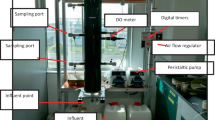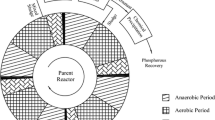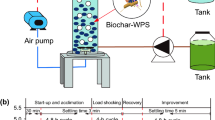Abstract
This study investigates the possibility to achieve aerobic granulation for the treatment of saline shipboard slop wastewater to remove hydrocarbons. Two sequencing batch reactors (SBR) with a working volume of 3.5 L, were used. In the first reactor (R1), granules were previously cultivated with a stepwise increase of salinity and, subsequently, they were gradually adapted to hydrocarbons. In the second reactor (R2), granules were simultaneously adapted to a gradual increase of salinity and hydrocarbons. Both the reactors were operated with an organic loading rate (OLR) of 1.6 KgCOD∙m−3·d−1, by setting a 6-hours cycle. The volumetric exchange ratio (VER) was fixed at 50% and the hydraulic retention time (HRT) was kept at 0.5 days. Five parallel phases of 30 days-duration were studied. When only slop was fed to reactor, in R1 the total suspended solids (TSS) and granules dimension decreased till about 4.7 g∙L−1 and 1.25 mm respectively, probably due to a metabolic inhibition and a breakage of granules. In R2 the TSS concentration stabilized on a value next to 4.4 g∙L−1 and no degranulation was observed (mean diameter ≈ 1 mm), probable due to a biological adaptation and a biodegradation of the adsorbed recalcitrant fraction. In R1, the reduction of total petroleum hydrocarbons (TPH) in liquid phase and the increase of TPH on granules, confirmed that a physical bioadsorption effect was dominant. In R2 a decreasing trend of TPH bioadsorbed on granules, together with a contextual depletion in liquid phase, suggested a probable occurrence of hydrolysis and biodegradation of the bioadsorbed hydrocarbons.
Similar content being viewed by others
References
APHA (2005). Standard methods for the examination of water and wastewater. American Water Works Association/American Public Works Association/Water Environment Federation
Beun JJ, Van Loosdrecht MCM, Heijnen JJ (2002) Aerobic granulation in a sequencing batch airlift reactor. Water Res 36:702–712. doi:10.1016/S0043-1354(01)00250-0
Corsino SF, Campo R, Di Bella G, Torregrossa M, Viviani G (2015) Cultivation of granular sludge with hypersaline oily wastewater. Int Biodeterior Biodegrad 105:192–202. doi:10.1016/j.ibiod.2015.09.009
De Kreuk MK, Heijnen JJ, Van Loosdrecht MCM (2005) Simultaneous COD, nitrogen, and phosphate removal by aerobic granular sludge. Biotechnol Bioeng 90:761–769
IMO-MARPOL 73/78 International Maritime Organizations regulation Prevention of Air Pollution from Ships
Author information
Authors and Affiliations
Editor information
Editors and Affiliations
Rights and permissions
Copyright information
© 2017 Springer International Publishing AG
About this paper
Cite this paper
Campo, R., Di Bella, G. (2017). Shipboard Slop Treatment by Means of Aerobic Granular Sludge: Strategy Proposal for Granulation and Hydrocarbons Removal. In: Mannina, G. (eds) Frontiers in Wastewater Treatment and Modelling. FICWTM 2017. Lecture Notes in Civil Engineering , vol 4. Springer, Cham. https://doi.org/10.1007/978-3-319-58421-8_85
Download citation
DOI: https://doi.org/10.1007/978-3-319-58421-8_85
Published:
Publisher Name: Springer, Cham
Print ISBN: 978-3-319-58420-1
Online ISBN: 978-3-319-58421-8
eBook Packages: EngineeringEngineering (R0)




